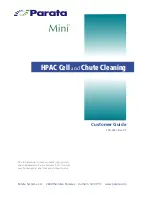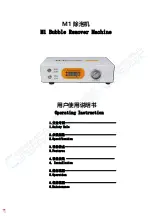
BT-550 Operation manual
42
P/N : 550-ENG-OPM-EUR-R01
Bistos Co., Ltd.
2018.03
are suspected, laboratory analysis (CO-Oximetry) of a blood sample
should be performed.
Venous congestion may cause under reading of actual arterial oxygen
saturation. Therefore, assure proper venous outflow from monitored site.
Sensor should not be below heart level (e.g. sensor on hand of a patient in a
bed with arm dangling to the floor).
Venous pulsation may cause erroneous low readings (e.g. tricuspid value
regurgitation).
Patient suffers from abnormal pulse rhythm.
The pulsations from intra-aortic balloon support can be additive to the pulse
rate on the oximeter pulse rate display. Verify patient’s pulse rate against the
ECG heart rate.
Use only Masimo approved accessories.
Motion artifact man lead to inaccurate measurements.
Elevated levels of Total Bilirubin may lead to inaccurate SpO2 measurements.
With very low perfusion at the monitored site, the readings may read lower
than core arterial oxygen saturation.
Do not expose the Pulse CO-Oximeter to excessive moisture such as direct
exposure to rain. Excessive moisture can cause the Pulse CO-Oximeter to
perform inaccurately or fail.
Do not immerse the sensor or patient cable in water or, solvents, or cleaning
solutions (The sensors and connectors are not waterproof).
Placement of a sensor on an extremity with a blood pressure cuff, arterial
catheter, or intravascular line.
The MS board can be used during defibrillation, but the readings may be
inaccurate for a short time.
Loss of pulse signal can occur in any of the following situation
-
The sensor is too tight
-
There is excessive illumination from light sources such as a surgical lamp, a
bilirubin lamp, or sunlight.
-
A blood pressure cuff is inflated on the same extremity as the one with a
SpO2 sensor attached
-
The patient has hypotension, severe vasoconstriction, severe anemia, or
hypothermia.
-
There is arterial occlusion proximal to the sensor.
-
The patient is in cardiac arrest or is in shock.
Pulse oximetry is a continuous and non-invasive method of measuring the level of arterial oxygen
saturation in blood. The measurement is taken by placing a sensor on a patient, usually on the fingertip
for adults, and the hand or foot for neonates. The sensor is connected to the pulse oximetry
instrument with a patient cable. The sensor collects signal data from the patient and sends it to the
instrument. The instrument displays the calculated data in two ways: 1) as a percent value for arterial
oxygen saturation (SpO
2
), and, 2) as a pulse rate (PR).
















































